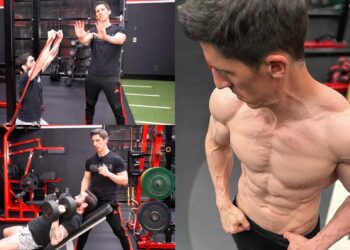Each year, millions of people set out to transform their bodies but have no clue where to start. Using improper form or choosing the wrong exercises can lead to injuries, cutting their fitness journey short before it even begins.
As a personal trainer with over 17 years in the trenches, I have curated eight foundational exercises and the safest starting point for beginners.
Mastering these movements will set a solid base for your future progress. It will also help prevent injuries down the line by improving your body’s adaptability.
The 8 Safest Beginner Exercises
With all that said and done, let’s break down the eight best exercises you can do to build a solid foundation:
1. Bodyweight Squat
Squats are considered the king of all exercises as they work the entire body. They mimic a fundamental human movement — sitting down and standing up. Plus, squats can improve hip and ankle mobility, boosting overall functionality.
Level Up Your Fitness: Join our 💪 strong community in Fitness Volt Newsletter. Get daily inspiration, expert-backed workouts, nutrition tips, the latest in strength sports, and the support you need to reach your goals. Subscribe for free!
How To Perform Squats Correctly
- Stand with your feet shoulder-width apart and toes slightly pointed out.
- Extend your arms in front of your chest for balance.
- While keeping your chest up and back neutral, start the movement by flexing your knees and pushing your hips back, like you are about to sit in a chair.
- Go as low as your mobility allows, but aim for thighs parallel to the floor.
- Push through your heels to return to be starting position and squeeze your glutes at the top of the range of motion (ROM).
Coach Tip: Beginners can place a sturdy chair or box behind them and lower themselves until their butt touches it. This limited ROM can help maintain better control.
Common Mistakes & How To Fix Them
- One of the biggest mistakes I see people make is that their knees cave in during the ascent. While it doesn’t increase injury risk, it can lead to muscle imbalances in the long run. Push your knees out slightly throughout the movement to overcome this issue.
- People with limited lower back or ankle mobility tend to lean forward or round their back during the eccentric phase. Avoid this by keeping your chest proud and your core engaged.
- Finally, place a rolled towel under your heels if they come up during the lowering phase.
2. Stationary Lunge (or Supported Lunge)
I love lunges because they challenge your balance and help iron out strength and muscle imbalances by working each leg individually. Lunges bias your quads, glutes, and hamstrings effectively while improving your coordination.
Beginners can opt for stationary lunges until comfortable with the movement mechanics.
How To Perform Stationary Lunges Correctly
- Stand upright with your feet together, and then take a comfortable step forward with one foot.
- Your feet should be about hip-width apart, side-to-side, to ensure optimal balance.
- Keeping your torso upright, flex your knees, hips, and ankles until your rear knee touches the floor.
- Perform a triple extension to return to the starting position.
- Maintain your weight mainly on your front foot, as that is the working leg. The rear leg is in a supporting role.
- Complete all repetitions on one side before switching to the other leg.
Coach Tip: Beginners can lower to a point where their back knee hovers just above the floor. Also, don’t let your knee track way over your ankle initially, as it can cause balance issues.
Common Mistakes & How To Fix Them
- Balance loss is the most common issue while performing lunges. Readjust your stance by placing your feet wider apart or taking a smaller stride to fix this issue. I encourage beginners to perform this exercise next to a wall for balance.
3. Plank
This exercise is incredibly effective for building core stability and upper body strength. Contrary to what most people think, you don’t need to be moving to build strength. Isometric exercises like planks are just as effective for this.
Planks work your abs, lower back, and shoulders while building endurance in crucial stabilizer muscles.
How To Perform Plank Correctly
- Get on all fours on the floor or a comfortable surface like a yoga mat.
- Position your hands on the floor parallel to each other so your elbows are directly under your shoulders. Extend your legs behind you so your body is in a straight line from head to heels.
- Brace your core muscles as hard as possible while maintaining a neutral spin. Do not let your hips sag down or rise toward the ceiling.
- Hold for the recommended time.
Coach Tip: Keep your head in line with your spine and look down to prevent unnecessary neck strain. Focus on breathing normally and avoid holding your breath.
4. Glute Bridge
The glutes are the biggest muscles in our bodies. Overlooking them can lead to serious physical implications over time. While squats can feel intimidating, you shouldn’t use that as an excuse to skip working out your lower body.
Glute bridges are an excellent exercise for strengthening the posterior chain with minimal lower back stress. They help improve hip extension, which is crucial for posture and power.
How To Perform Glute Bridge Correctly
- Lie on your back with your knees bent and feet flat on the floor, about hip-width apart.
- Rest your hands on your side with your palms facing down.
- Engage your core and push through your heels to lift your hips off the floor.
- Your body should form a straight line from your shoulders to your knees at the top of your ROM. Contract your glutes as hard as possible at the top to maximize target muscle fiber stimulation.
- Hold the top position for a couple of seconds before returning to the starting position.
Coach Tip: If lifting high causes discomfort, raise your hips only a few inches off the ground and focus purely on squeezing your glutes.
Common Mistakes & How To Fix Them
- I notice that many people tend to push their stomachs out by arching their lower backs excessively at the top. This can cause lower back strain and does not provide any additional benefit.
- Avoid initiating the movement with the lower back. Focus on your glutes throughout the ROM.
- Finally, your knees should track in line with your hips and feet throughout the exercise. Don’t let your knees fall outward or inward.
5. Bird-Dog
In my opinion, the bird-dog is one of the most underrated foundational exercises. It challenges your balance and coordination while protecting the spine. There aren’t many exercises that we can say this about.
Level Up Your Fitness: Join our 💪 strong community in Fitness Volt Newsletter. Get daily inspiration, expert-backed workouts, nutrition tips, the latest in strength sports, and the support you need to reach your goals. Subscribe for free!
Bird-dog trains your abs, back muscles, glutes, and shoulders. Plus, this exercise teaches you to keep your core stable while your limbs are moving. It can improve your overall functionality in daily activities and sports.
How To Perform Bird-Dog Correctly
- Start in a tabletop position with your hands directly under your shoulders and your knees under your hips.
- Your back should be neutral throughout this exercise.
- Slowly extend one arm straight forward and the opposite leg straight back simultaneously. Both these limbs should be parallel to the floor in the fully extended position.
- Do not let your hips twist or your back round during this movement.
- Reach long through your extended heel and fingertips to maximize the stretch.
- Return to the starting position and switch sides.
Coach Tip: Imagine balancing a glass of water on your lower back as you perform this exercise. Beginners can extend just one forward, return, and extend the opposite left back until they gain enough experience.
Common Mistakes & How To Fix Them
- Many people tend to move a lot while switching legs and arms. Focus on maintaining a stable core throughout the exercise, and the arms and legs should be the only moving parts.
- Avoid arching the lower back when extending the leg and squeeze the glute of the extended leg for optimal muscle fiber activation.
6. Incline Push-Up / Wall Push-Up
Push-ups are one of the best beginner-friendly upper-body exercises, as they target the chest, shoulders, and triceps. However, I recommend you perform this exercise on an incline, as it reduces the amount of body weight you have to lift, making it easier while reinforcing the proper technique.
How To Perform Incline Push-Ups Correctly
- Stand facing a sturdy elevated surface like a wall or countertop.
- Position your hands shoulder-width apart on the surface.
- Step your feet back so your body forms a straight line from your head to your heels. Engage your core and glutes to ensure optimal form.
- Bend your elbows and lower your chest toward the surface.
- Explode back to the starting position.
Coach Tip: Slow down the rep tempo as you get comfortable with the movement mechanics. For instance, instead of taking a second on the eccentric phase, aim for three seconds.
Common Mistakes & How To Fix Them
- Many exercisers tend to flair their elbows excessively during this exercise, which can remove the tension from the target muscles, like the chest, and place it on secondary muscles, like the shoulder rotator cuffs.
- Avoid letting your hips sag or hike up. Maintain your body in a straight line throughout the movement.
7. Inverted Row
Your workouts should balance lower body, pushing, and pulling movements to ensure overall development. The inverted rows strengthen the back muscles, which can help improve your posture and balance out the chest work.
How To Perform Inverted Rows Correctly
- Position two chairs side by side, leaving enough space between them for you to stand comfortably.
- Position a broomstick across these chairs while ensuring it doesn’t slip. You can use a towel or cushion for this.
- Lie down on the floor between the chairs so your chest is directly under the broomstick.
- Grab it with a shoulder-wide overhand grip.
- Your upper body should be clear off the floor in the starting position.
- Flex your elbows to lift your chest toward the stick.
- Pause in the fully contracted position.
- Slowly return to the starting position.
Coach Tip: Walk your feet further away from the stick to make this exercise more challenging. Prioritize a deep mind-muscle connection while performing this exercise to get the best bang for your training buck.
Common Mistakes & How To Fix Them
- Many lifters tend to arch their back during the pulling motion. However, this can limit the tension on the back. You must maintain a plank-like body position throughout this exercise.
8. Dead Bug
This unassuming exercise is incredibly effective for boosting core control and spinal stability. Plus, it is excellent for sedentary people who have never exercised before.
How To Perform The Dead Bug Correctly
- Lie on your back with your knees bent and feet flat on the floor.
- Engage your core and gently press your lower back against the floor.
- While maintaining a 90-degree knee angle, lift your feet so your lower legs are parallel to the floor.
- Raise your arms straight up towards the ceiling, directly over your shoulders.
- Slowly lower one arm straight back towards the floor behind your head while lowering the opposite leg straight out until your heel hovers just above the floor.
- Return to the starting position and repeat with the other arm and leg.
Coach Tip: Novices can lower one leg at a time, keeping arms still, or vice versa.
Common Mistakes & How To Fix Them
- Even though these are bodyweight beginner-friendly exercises, you shouldn’t overlook the importance of proper warm-ups and cool-downs. Start with a 5-10 minute dynamic stretching routine to improve mobility and end with static stretches to promote recovery. (1)
- Avoid moving too quickly or without control, as it can hamper the target muscle recruitment.
Putting It All Together
Now that you know about the eight best beginner-friendly exercises, it is time to put this knowledge to work. Here is a sample starting workout to help you build a solid foundation:
| Exercise | Sets | Reps | Rest (after set) |
| Bodyweight Squat | 2-3 | 8-12 | 60-90 seconds |
| Incline Push-Up | 2-3 | 8-12 | 60-90 seconds |
| Glute Bridge | 2-3 | 10-15 | 60-90 seconds |
| Bird-Dog | 2-3 | 8-12 per side | 60-90 seconds |
| (Choose 0-1 more) | 2-3 | 8-12 | 60-90 seconds |
Aim to perform this workout on two or three non-consecutive days per week. This will ensure your body has enough time to recover and grow stronger.
Learn to listen to your body. Scale your training volume and intensity, depending on how your body is reacting to this new routine. Discontinue a workout immediately if you are experiencing sharp pain and consult your doctor if it doesn’t go away within a couple of days.
Conclusion
Air squats, lunges, planks, glute bridges, bird-dogs, incline push-ups, inverted rows, and dead bugs are some of the best foundational exercises for beginners. Prioritize a picture-perfect form by focusing on your breathing, core engagement, and mind-muscle connection to make the most of these exercises.
Remember, you do not have to perform all these exercises from the very first day. Begin by including one to two exercises in your routine, and increase the overall training volume as you gain more experience. Consistency and commitment to this new fitness routine will help you achieve your fitness objectives in no time.
If you have any questions about the eight exercises listed in this article, post them in the comments below, and I’ll be happy to help!
References:
- Arntz F, Markov A, Behm DG, Behrens M, Negra Y, Nakamura M, Moran J, Chaabene H. Chronic Effects of Static Stretching Exercises on Muscle Strength and Power in Healthy Individuals Across the Lifespan: A Systematic Review with Multi-level Meta-analysis. Sports Med. 2023 Mar;53(3):723-745. doi: 10.1007/s40279-022-01806-9. Epub 2023 Jan 31. PMID: 36719536; PMCID: PMC9935669.









